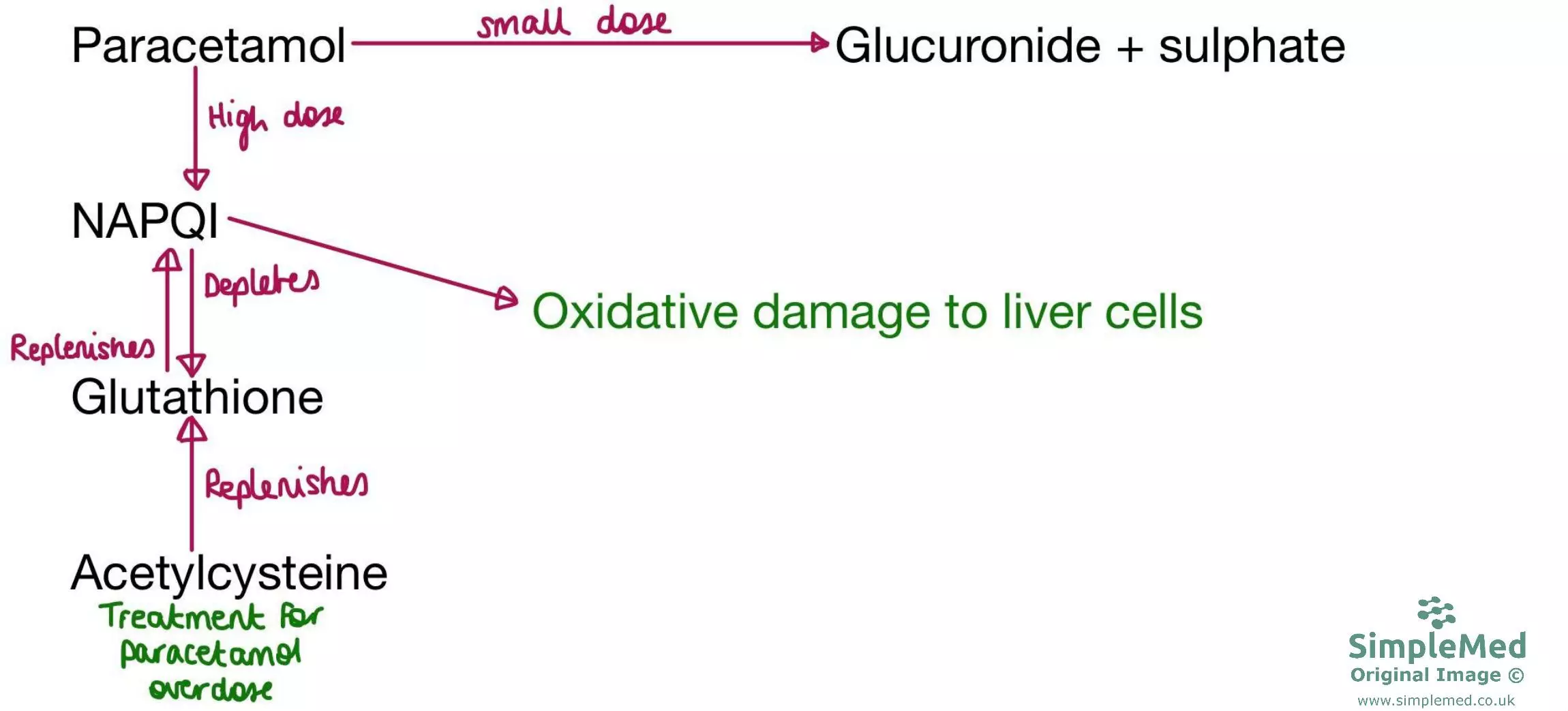Next Lesson - Energy Storage
Abstract
- Reactive oxygen species contain an oxygen atom with a free radical making them extremely reactive. They can react with other molecules leading to harmful consequences if they go unchecked. An example of a reactive oxygen species used by the body is nitric oxide.
- Oxidative stress is where there is an imbalance between the reactive oxygen species and the cell's defences against free radicals.
- There are many defences against free radicals which include: superoxide dismutase and catalase; glutathione; free radical scavengers.
- Paracetamol at toxic doses causes the production of NAPQI, resulting in oxidative stress and damage to the liver if acetylcysteine is not given to treat the overdose.
Core
A reactive oxygen species (ROS) is a molecule that contains oxygen and a free radical (an unpaired electron in the outer shell). Not all free radicals are a ROS as some do not contain oxygen.
Oxidative stress occurs when the balance between reactive oxidative species and the cell's defences get out of balance. It plays a part in the pathogenesis many diseases such as cancer, chronic obstructive pulmonary disease, cardiovascular disease, multiple sclerosis and Parkinson’s through causing damage to cells.
There are many types of damage that can occur because of reactive oxygen species:
- Base damage or sugar DNA damage, leading to DNA mutation.
- Protein damage through the formation of inappropriate disulphide bonds.
- Disruption of lipid structures (including cell membranes) by creating a chain reaction of lipid radicals.
Nitric oxide (NO•) is an example of both a free radical and a ROS. It is useful in the body as it signals vasodilation, angiogenesis, oxidative bursts and neurotransmission. However, it is toxic at high levels because it is a ROS, so levels need to be controlled.
It is formed through a reaction between arginine (an amino acid) and oxygen to produce nitric oxide, water and citrulline (a different amino acid). This is catalysed by the enzyme nitric oxide synthase (NOS).
The respiratory burst is an emission from a phagocytic cell designed to kill bacteria. It contains H2O2 (hydrogen peroxide) or O2-• (superoxide) which is used to make HOCl• (hypochlorite/bleach). The cell also releases peroxynitrite (ONOO-), produced from nitric oxide and superoxide. The HOCl• and ONOO- are used to kill the bacteria.
This relates to Chronic Granulomatous Disease (CGD) which is a form of immunodeficiency. In CGD, cells fail to produce this respiratory burst and so bacterial infections can become very severe. The disease gets it's name from the granulomas that form in organs to try to contain the infection. The formation of these granulomas damages the organs.
Cells have defences against the ROS that can cause damage.
The first of these is an enzyme called superoxide dismutase (SOD), which catalyses the reaction between superoxide (O2-•) and 2 hydrogen ions (H+) to produce hydrogen peroxide (H2O2). This is key because it stops the radical chain reaction from propagating. Even though hydrogen peroxide is damaging to cells, it can undergo a reaction to become water and oxygen. This reaction is catalysed by the enzyme catalase. This effectively transfers the radical into two less dangerous molecules.

Diagram - The reactions of superoxide dismutase and catalase
SimpleMed original by Maddie Swannack
A second type of cellular defence is glutathione (GSH). It uses NADPH from the pentose phosphate pathway to help convert H2O2 into H2O according to the equation below, while becoming oxidised and reduced itself. The oxidised form of glutathione is GSSG.

Diagram - The reaction pathway of glutathione
SimpleMed original by Maddie Swannack
The NADPH used for this come from the pentose phosphate pathway, but this requires the enzyme glucose-6-phosphate dehydrogenase (G6PDH), which can be genetically deficient in some individuals. If there is a deficiency in G6PDH, NADPH levels are too low to regenerate GSH in cells without mitochondria (for example red blood cells), leading to these cells not being able to neutralise ROS and causing inappropriate disulphide bond formation in these cells. This causes Heinz bodies to form in the red blood cells, which are aggregations of haemoglobin caused by the inappropriate disulphide bond formation.
A third way that cells defend themselves against free radicals within the cell is through free radical scavengers. These include vitamins A, C and E. Vitamin E donates a H+ ion to the radical to neutralise it. Vitamin C regenerates vitamin E so it can perform its function.
Paracetamol metabolism also involves glutathione. When taken at therapeutic doses, paracetamol can be safely metabolised into glucuronide and sulphates which can be excreted in the urine.
However, in an overdose, the safe pathway is saturated, and paracetamol is metabolised through an alternative pathway. This alternate pathway produces NAPQI as a product. As NAPQI depletes glutathione (the active GSH is oxidised to inactive GSSG) and there is not enough NADPH to regenerate GSH from GSSG, NAPQI builds up and can cause oxidative damage to cells of the liver.
The treatment for a paracetamol overdose is acetylcysteine, which replenishes glutathione, so that it can prevent some of the damage to liver cells.

Diagram - The pathway of paracetamol metabolism
SimpleMed original by Maddie Swannack
Edited by: Dr. Ben Appleby
Reviewed by: Dr. Thomas Burnell
- 10243

